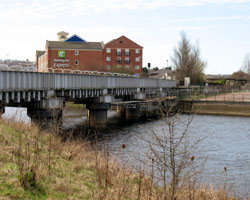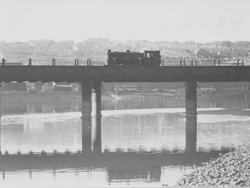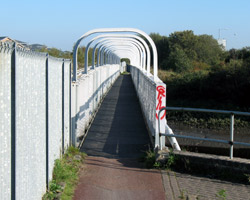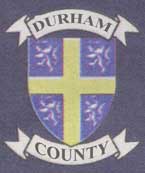
DERWENTHAUGH RAILWAY BRIDGE
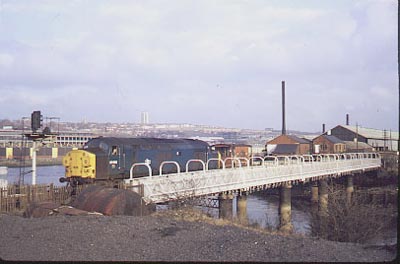
The first bridge on the Derwent is situated right at its confluence with the River Tyne. Originally part of the Blaydon, Gateshead and Hebburh Railway conceived in 1831 to run along the south bank of the Tyne but needing to cross the Derwent near its mouth. The railway company ran into financial difficulties and was aided by the Newcastle and Carlisle Railway which took over the line from Blaydon to Redheugh in Gateshead. The line crossed the Derwent on a wooden bridge, opening in 1836 as far as Derwenthaugh where there was a station, and in 1837 opened through to Redheugh, with a passenger as well as a goods service from that date until 1850, resuming briefly in 1852 for a year from when passenger services were withdrawn east of Derwenthaugh. Passenger services ceased entirely on the line in 1868 when the line from Scotswood to Consett running up the Derwent valley was opened.
The wooden bridge was replaced with the present iron girder structure across the Derwent in 1865/66. Freight trains continued to use the bridge until 1982 when the line again carried passenger services with the closure of the Newcastle to Blaydon via Scotswood section of the Newcastle and Carlisle line and running north of the Tyne closed, and all trains (except some coal trains serving Stella North power station) were diverted via the King Edward Bridge at Newcastle, reaching Blaydon via Dunston and Derwenthaugh south of the Tyne. The Derwenthaugh line, including the bridge, became part of the North Eastern Railway from 1862. Freight traffic at Derwenthaugh was heavy, with coal, bricks, iron and steel and clay being carried, and of course a massive coal traffic at the nearby staiths. There was a complicated series of junctions near Derwenthaugh allowing trains to reach Swalwell, one mile up the Derwent, from either the Scotswood, Blaydon or Dunston direction.
The bridge at Derwenthaugh was renovated in 2002/03 at a cost believed to be £4 million. The foundations for the original wooden bridge, replaced at an unknown date by the present bridge shown below, can still be seen at low tide in the River Derwent next to the existing bridge, which also carries a footbridge on the south side. As mentioned above, the line through Derwenthaugh carries the passenger service from Newcastle to Hexham and Carlisle, now calling at the Metrocentre station. The Derwent here at its confluence with the Tyne falls and rises considerably with the tide. At low tide it is merely a narrow flow at the bottom of a fairly deep valley with steep banks. At high tide however, the Derwent is much wider, covering the mud banks and flowing up over the weir half a mile upstream to reach its tidal limit at the Dam Head. The mud, once black, is very gradually becoming lighter as decades of pollution are cleansed from the river bed following the closure of the iron and steel works at Consett, the coke works at Winlaton Mill and the general clean-up of the Tyne. Railway number NEC1-29.
Note on photographs - The top picture shows a relaying train going west towards Blaydon in the 1980s, hauled by a Class 37 locomotive. The lower pictures show saddle tank locomotive number 68010 in June 1957 and the footbridge alongside after the deck was renewed in October 2011.
- Constructed - 1865/66
- Type - beam, girder, iron.
- Position: At mouth of river, Derwenthaugh, Tyne and Wear.
- Grid Ref: NZ 205 633
